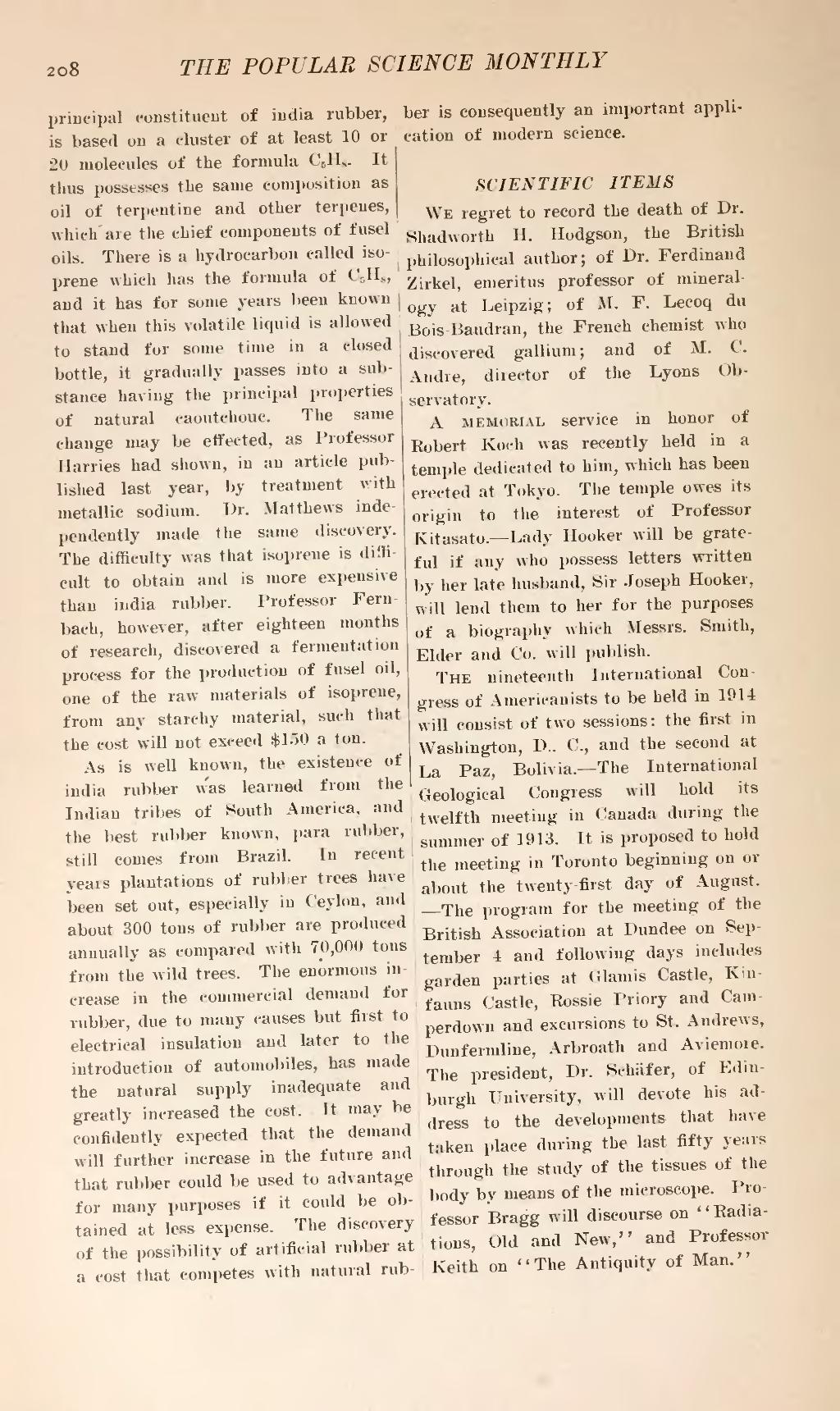principal constituent of india rubber, is based on a cluster of at least 10 or 20 molecules of the formula . It Thus possesses the same composition as oil of terpentine and other terpenes, which are the chief components of fusel oils. There is a hydrocarbon called isoprene which has the formula of , and it has for some years been known that when this volatile liquid is allowed to stand for some time in a closed bottle, it gradually passes into a substance having the principal properties of natural caoutchouc. The same change may be effected, as Professor Harries had shown, in an article published last year, by treatment with metallic sodium. Dr. Matthews independently made the same discovery. The difficulty was that isoprene is difficult to obtain and is more expensive than india rubber. Professor Fernbach, however, after eighteen months of research, discovered a fermentation process for the production of fusel oil, one of the raw materials of isoprene, from any starchy material, such that the cost will not exceed $150 a ton.
As is well known, the existence of india rubber was learned from the Indian tribes of South America, and the best rubber known, para rubber, still comes from Brazil. In recent years plantations of rubber trees have been set out, especially in Ceylon, and about 300 tons of rubber are produced annually as compared with 70,000 tons from the wild trees. The enormous increase in the commercial demand for rubber, due to many causes but first to electrical insulation and later to the introduction of automobiles, has made the natural supply inadequate and greatly increased the cost. It may be confidently expected that the demand will further increase in the future and that rubber could be used to advantage for many purposes if it could be obtained at less expense. The discovery of the possibility of artificial rubber at a cost that competes with natural rubber is consequently an important application of modern science.
SCIENTIFIC ITEMS
We regret to record the death of Dr. Shadworth H. Hodgson, the British philosophical author; of Dr. Ferdinand Zirkel, emeritus professor of mineralogy at Leipzig; of M. F. Lecoq du Bois-Baudran, the French chemist who discovered gallium; and of M. C. Andre, director of the Lyons Observatory.
A memorial service in honor of Bobert Koch was recently held in a temple dedicated to him, which has been erected at Tokyo. The temple owes its origin to the interest of Professor Kitasato.—Lady Hooker will be grateful if any who possess letters written by her late husband, Sir Joseph Hooker, will lend them to her for the purposes of a biography which Messrs. Smith, Elder and Co. will publish.
The nineteenth International Congress of Americanists to be held in 1914 will consist of two sessions: the first in Washington, D. . C, and the second at La Paz, Bolivia.—The International Geological Congress will hold its twelfth meeting in Canada during the summer of 1913. It is proposed to hold the meeting in Toronto beginning on or about the twenty-first day of August.—The program for the meeting of the British Association at Dundee on September-4 and following days includes garden parties at Glamis Castle, Kinfauns Castle, Rossie Priory and Camperdown and excursions to St. Andrews, Dunfermline, Arbroath and Aviemore. The president, Dr. Schäfer, of Edinburgh University, will devote his address to the developments that have taken place during the last fifty years through the study of the tissues of the body by means of the microscope. Professor Bragg will discourse on "Radiations, Old and New," and Professor Keith on "The Antiquity of Man."

